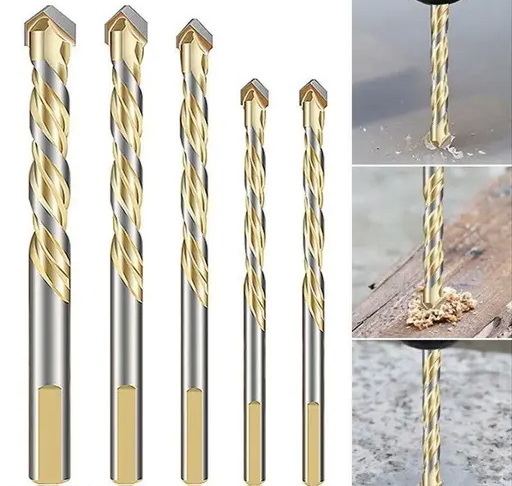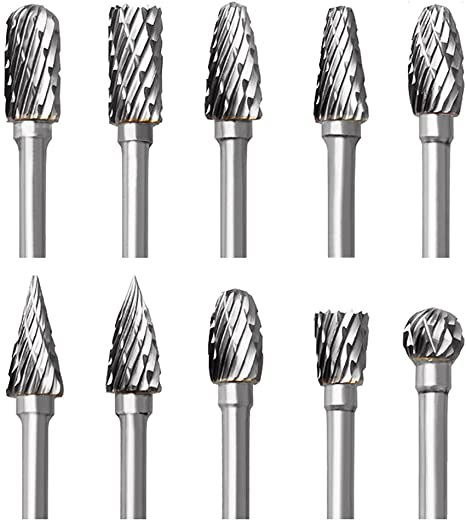Content Menu
● Introduction to Cemented Tungsten Carbide
>> Visual Representation of Cemented Tungsten Carbide Structure
● Composition and Structure
>> Main Components
>> Phases in Cemented Carbide
● Manufacturing Process
>> 1. Powder Preparation
>> 2. Mixing and Milling
>> 3. Compacting
>> 4. Sintering
>> 5. Finishing
● Physical and Mechanical Properties
● Advantages and Disadvantages
>> Advantages
>> Disadvantages
● Applications of Cemented Tungsten Carbide
>> Cutting Tools
>> Wear-Resistant Parts
>> Molds and Dies
>> Ammunition
● Types and Grades of Cemented Tungsten Carbide
● Conclusion
● FAQ
>> 1. What is the difference between cemented tungsten carbide and pure tungsten carbide?
>> 2. How is cemented tungsten carbide manufactured?
>> 3. Why is cobalt used as a binder in cemented tungsten carbide?
>> 4. What are the main applications of cemented tungsten carbide?
>> 5. What are the limitations of cemented tungsten carbide?
● Citations:
Cemented tungsten carbide is a composite material widely used in industrial applications, especially for cutting tools, wear-resistant parts, and molds. It combines the extreme hardness of tungsten carbide particles with the toughness of a metallic binder, typically cobalt, to create a material that is both hard and durable. This article explores the composition, manufacturing process, properties, applications, and advantages of cemented tungsten carbide, supported by detailed explanations and illustrative images.

Introduction to Cemented Tungsten Carbide
Cemented tungsten carbide, often simply called cemented carbide or hardmetal, is a metal matrix composite. It consists of fine tungsten carbide (WC) particles cemented together by a metallic binder, usually cobalt (Co). This structure is analogous to concrete, where gravel is held together by cement. The carbide particles provide hardness and wear resistance, while the binder adds toughness and impact resistance, balancing the material's overall performance[1][3][10].
Visual Representation of Cemented Tungsten Carbide Structure
Composition and Structure
Main Components
- Tungsten Carbide (WC): The hard phase, typically 70% to 97% by weight, provides exceptional hardness and wear resistance. Tungsten carbide has a very high melting point (~2900°C) and is extremely hard, ranking about 9 on the Mohs scale[1][9][10].
- Cobalt (Co): The binder phase, usually 3% to 30%, holds the carbide grains together, providing toughness and resistance to fracture[1][10].
- Other Carbides: Sometimes titanium carbide (TiC), tantalum carbide (TaC), or niobium carbide (NbC) are added to improve specific properties like corrosion resistance or toughness[1][10].
Phases in Cemented Carbide
- α-phase (Alpha): Tungsten carbide grains.
- β-phase (Beta): Metallic binder (cobalt or alternatives).
- γ-phase (Gamma): Other carbides like TiC or TaC when present[10].
Manufacturing Process
The production of cemented tungsten carbide involves several key steps:
1. Powder Preparation
Tungsten powder is mixed with carbon black and milled to ensure uniformity. This mixture is carburized at high temperatures (1300–1600°C) to form tungsten carbide powder[2].
2. Mixing and Milling
The tungsten carbide powder is blended with cobalt powder and other additives in a ball mill to achieve a homogeneous mixture[2][8].
3. Compacting
The powder mixture is pressed into the desired shape using molds or dies.
4. Sintering
The compacted shape is heated to about 1400–1500°C in a sintering furnace. During sintering, the cobalt binder melts and binds the tungsten carbide grains together, shrinking the volume by about 50% and forming a dense, solid composite[1][8][10].
5. Finishing
The sintered parts are ground, lapped, or polished to achieve precise dimensions and surface finish[8][10].

Physical and Mechanical Properties
| Property | Cemented Tungsten Carbide | Comparison (High-Speed Steel) |
| Hardness | 69–81 HRC | Lower (typically 60 HRC max) |
| Compressive Strength | ~6000 MPa | Much lower |
| Elastic Modulus | ~550–735 GPa | ~200 GPa |
| Thermal Conductivity | ~84 W/m·K | Lower |
| Coefficient of Thermal Expansion | ~5.8 µm/m·K | Higher |
| Wear Resistance | Extremely high | Moderate |
| Toughness | Moderate (depends on Co content) | Higher but less hard |
| Density | ~15 g/cm³ | ~7.8 g/cm³ (steel) |
Cemented tungsten carbide is extremely hard and wear-resistant, second only to diamond in hardness. It maintains hardness at elevated temperatures (up to 900–1000°C) and resists corrosion and oxidation better than many metals[4][5][9].
Advantages and Disadvantages
Advantages
- Exceptional Hardness and Wear Resistance: Ideal for cutting tools and wear parts.
- High Strength and Elastic Modulus: Maintains dimensional stability under stress.
- Thermal Stability: Retains hardness at high temperatures.
- Corrosion and Oxidation Resistance: Suitable for harsh environments.
- Long Tool Life: Cutting tools last 5 to 80 times longer than high-speed steel tools[4][5][6].
Disadvantages
- Brittleness: Lower toughness compared to steels; prone to chipping under impact.
- Cost: Expensive due to tungsten and cobalt content.
- Processing Difficulty: Requires specialized equipment like diamond grinding wheels for machining[5].
Applications of Cemented Tungsten Carbide
Cutting Tools
Cemented tungsten carbide is the material of choice for metal cutting tools such as drills, milling cutters, lathe tools, and inserts. It allows faster machining speeds and better surface finishes compared to high-speed steel[1][12].
Wear-Resistant Parts
Used in mining, construction, and manufacturing for parts exposed to abrasion, such as rock drilling bits, crushing tools, and wear plates[5][9].
Molds and Dies
Widely used in cold work molds, powder metallurgy dies, and extrusion dies due to its wear resistance and dimensional stability[6][5].
Ammunition
Used in armor-piercing projectiles due to its high density and hardness[12].
Types and Grades of Cemented Tungsten Carbide
Cemented carbides are classified based on grain size and cobalt content:
| Grade Type | Grain Size (μm) | Cobalt Content (%) | Characteristics |
| Submicron | <1 | 6–12 | Very hard, high wear resistance |
| Fine | 1–3 | 6–12 | Balanced hardness and toughness |
| Medium | 3–5 | 10–15 | Good toughness, moderate hardness |
| Coarse | >5 | 15–30 | Highest toughness, lower hardness |
Special grades include corrosion-resistant carbides with alloyed binders (e.g., nickel, chromium) for harsh environments[3][7][10].
Conclusion
Cemented tungsten carbide is a remarkable engineered material combining the hardness of tungsten carbide with the toughness of a metallic binder, typically cobalt. Its unique properties make it indispensable in cutting tools, wear-resistant parts, molds, and even ammunition. Despite its brittleness and cost, its superior wear resistance, thermal stability, and strength ensure it remains a critical material in modern manufacturing and industrial applications. Advances in powder metallurgy and material science continue to enhance its performance, broadening its applications and improving cost efficiency.

FAQ
1. What is the difference between cemented tungsten carbide and pure tungsten carbide?
Cemented tungsten carbide is a composite material where tungsten carbide particles are bonded by a metallic binder (usually cobalt), whereas pure tungsten carbide is a single-phase ceramic material. The binder adds toughness and reduces brittleness[1][10].
2. How is cemented tungsten carbide manufactured?
It is made by mixing tungsten carbide powder with cobalt powder, compacting the mixture into shape, and sintering it at high temperatures to fuse the particles into a dense, solid composite[2][8][10].
3. Why is cobalt used as a binder in cemented tungsten carbide?
Cobalt provides toughness and ductility to the otherwise brittle tungsten carbide, improving impact resistance and overall durability of the composite[1][10].
4. What are the main applications of cemented tungsten carbide?
It is primarily used in cutting tools, wear-resistant parts, molds, dies, and armor-piercing ammunition due to its hardness and wear resistance[1][5][12].
5. What are the limitations of cemented tungsten carbide?
Its main limitations are brittleness, susceptibility to chipping under impact, high cost, and the need for specialized equipment for machining and finishing[5].
Citations:
[1] https://en.wikipedia.org/wiki/Cemented_carbide
[2] https://heegermaterials.com/blog/90_how-is-tungsten-carbide-made-.html
[3] https://www.kennametal.com/us/en/products/carbide-wear-parts/fluid-handling-and-flow-control/separation-solutions-for-centrifuge-machines/tungsten-carbide-materials.html
[4] https://www.zzsinocarbide.com/faq.html
[5] https://www.everloy-cemented-carbide.com/en/column/782/
[6] https://huanatools.com/cemented-carbide-grades-properties-and-uses/
[7] https://www.youtube.com/watch?v=i5wCxOX5P6s
[8] https://www.zgcccarbide.com/news/The-Manufacturing-Process-of-Cemented-Carbide-Inserts:-A-Comprehensive-Guide-39.html
[9] http://www.tungsten-carbide.com.cn
[10] https://www.hyperionmt.com/en/Resources/materials/cemented-carbide/
[11] https://www.sanalloy.co.jp/en/q_a/
[12] https://en.wikipedia.org/wiki/Tungsten_carbide
[13] https://www.rydmetcarbide.com/faq/
[15] https://www.nittan.co.jp/en/products/hard_metal_008_031.html
[16] https://www.azom.com/article.aspx?ArticleID=1203
[17] https://www.youtube.com/watch?v=65lAKakQte4
[18] https://www.ceratizit.com/int/en/company/passion-for-cemented-carbide-/cemented-carbide.html
[19] https://www.articlecube.com/tungsten-carbide-cemented-carbide-and-carbide-whats-difference
[20] https://www.sciencedirect.com/topics/materials-science/cemented-carbide
[21] https://oricus-semicon.com/materials/cemented-carbide/
[22] https://huanatools.com/wp-content/uploads/2021/06/3N8A0944.jpg?sa=X&ved=2ahUKEwjo38KLvNqMAxXqFDQIHb-qPQ4Q_B16BAgBEAI
[23] https://www.psmindustries.com/yillik/tungsten-carbide-manufacturing-process
[24] https://www.hyperionmt.com/globalassets/new-images/all-about-cemented-carbide/cemtented-carbide-production-process.png?sa=X&ved=2ahUKEwiFpMaLvNqMAxXeslYBHYsXE9sQ_B16BAgLEAI
[25] https://www.ceratizit.com/int/en/company/passion-for-cemented-carbide-/production.html
[26] https://www.istockphoto.com/photos/tungsten-carbide
[27] https://www.alamy.com/stock-photo/tungsten-carbide.html
[28] https://techlinkcenter.org/technologies/cemented-carbide-material-based-on-tungsten-carbide-and-iron-based-alloy/6cec005f-afc3-40ba-8341-1d1b70ada0b7
[29] https://www.istockphoto.com/photos/carbide-tools
[30] https://stock.adobe.com/search/images?k=carbide+cutting
[31] https://www.istockphoto.com/photos/tungsten-carbide?page=2
[32] https://www.shutterstock.com/search/cemented-carbide
[33] https://www.heattreattoday.com/an-overview-of-cemented-carbide-sintering/
[34] https://www.ceratizit.com/int/en/sustainability/blog/2021/blogposting-cemented-carbide.html
[35] https://www.istockphoto.com/photos/cemented-carbide
[36] https://www.youtube.com/watch?v=dkFuZVBTTS0
[37] https://www.shutterstock.com/search/carbide-cutting-tools
[38] https://guesstools.com/et/cemented-carbide-vs-tungsten-carbide/
[39] https://www.everloy-cemented-carbide.com/en/knowledge/faq.html
[40] https://www.generalcarbide.com/wp-content/uploads/2019/04/GeneralCarbide-Designers_Guide_TungstenCarbide.pdf
[41] https://guesstools.com/da/cemented-carbide-vs-tungsten-carbide/
[42] https://www.youtube.com/watch?v=i5wCxOX5P6s
[43] https://www.carbidetek.com/faqs/
[44] https://www.practicalmachinist.com/forum/threads/carbide-question.86468/post-164612
[45] https://www.sandvik.coromant.com/en-us/services/recycling/faq-carbide-recycling
[46] https://www.sundicuttingtools.com/news/technology-articles/cemented-carbide-cutting-tool-material-basics-summary/
[47] http://www.carbidetechnologies.com/faqs/
[48] https://www.samaterials.com/content/cemented-carbide-vs-tungsten-steel.html
[49] https://patents.google.com/patent/US4008090A/en
[50] https://todaysmachiningworld.com/magazine/how-it-works-making-tungsten-carbide-cutting-tools/
[51] https://www.alamy.com/stock-photo/carbide-end-mill.html
[52] https://en.wikipedia.org/wiki/Tungsten_carbide
[53] https://ceramics.org/ceramic-tech-today/tungsten-carbide-made-easy-government-industry-academia-investigate-additively-manufacturing-cemented-carbide-parts/
















